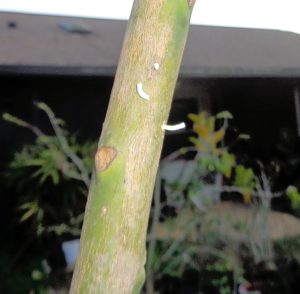
While ambrosia is often called the “food of the gods”, when it is attached to the ambrosia beetle, it is not so heavenly. In fact, ambrosia beetles are taking advantage of freeze-damaged trees in our area as they bore in and reproduce across the landscape. Not to be confused with the redbay ambrosia beetle which attacks redbay trees and avocadoes and infects them with laurel wilt disease, the granulated ambrosia beetle is an opportunistic insect that is attracted to freeze-stressed trees. While there is not much you can do about this critter, there are signs of its activity that stand out like a sore thumb.
Ambrosia beetles are named “ambrosia” as they cultivate a certain fungus for their larvae in an interesting, almost maternal, behavior. Once a freeze-stressed tree has been detected, the 1/16-inch-long female beetle bores a small hole into the bark and begins to tunnel inside. Freeze-stressed trees offer little to no resistance to the invading beetles. As the beetle tunnels, a narrow tube of frass – tightly packed wood dust – pushes out the hole almost looking like a short toothpick. These frass tubes are very fragile and arch a bit as they emerge and eventually break off in a wind. Inside the tree, the female ambrosia beetle chews out small galleries to lay eggs and house the subsequent larvae. Within the galleries, the female beetle deposits the symbiotic ambrosia fungus which grows producing the sustenance for both beetle larvae and adults – in effect farming their own food. The frass tubes are a sign that the tree has been compromised – first by the freeze and then by the beetles.
What trees have I seen attacked by granulated ambrosia beetles? Over the years, the number one victim were smaller-sized Royal Poincianas. These marginal trees were often planted in a cooler area that was prone to freezes. I have also seen and suffered from these beetles going after mango, mahogany, coffee, jackfruit, and pigeon peas. I have also seen them once nor twice in foxtail palms. Young trees, especially marginally hardy trees, can be victims of this beetle. The beetle is really not to blame, it is simply taking advantage of an opportunity provided by the freeze damage. Will these trees survive? It all depends, but I would not count on it. It is really up to the tree as far as its ability to compartmentalize the damage and begin to grow out of the injury. The short answer is that the tree will not recover and that its carcass will simply become a reservoir of granulated ambrosia beetles which can then further infest other stressed trees – as such, remove dead, infested trees. Once the beetles are inside, they are well-protected by the frass tube so any chemical control is difficult at best. The beetle is so small you may never detect them before they quickly move inside.
The moral of the story is that every once in a awhile we have a colder than normal winter – a test winter – and tropical to subtropical trees (especially young specimens) subjected to this cold are not designed to take the hit. As many of these trees grow and develop some size, their ability to cope, repel pests, and regrow increases. Find micro-climates where you can and keep Hardiness Zones in mind when you plant. For more information on all types of gardening issues common to our Southwest Florida landscapes, or to ask a question, please visit https://www.facebook.com/CharlotteMGLifeline/ . Ralph E. Mitchell is the Director/Horticulture Agent for the UF/IFAS Charlotte County Extension Service. He can be reached at 941-764-4344 or ralph.mitchell@charlottecountyfl.gov.
Resources:
Bolles, B. (2014) Alert: Ambrosia Beetles ! The University of Florida Extension Service, IFAS.
Atkinson, T. H., Foltz, J. L., Wilkinson, R. C., & Mizell, R. F. (2020)Granulate Ambrosia Beetle Xylosandrus crassiusculus (Motschulsky) (Insecta: Coleoptera: Curculionidae: Scolytinae). The University of Florida Extension Service, IFAS.
Boggs, J. (2018) Unheavenly Ambrosia Beetles. The Ohio State University.
Ambrosia, https://en.wikipedia.org/wiki/Ambrosia
 1
1
